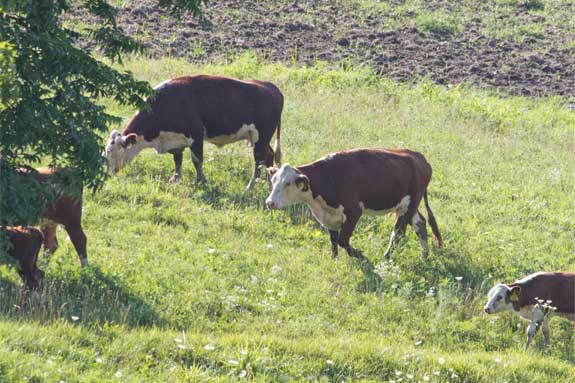Having healthy calves is an important component of successful marketing of calves sold at or near weaning, as well as to assure that calves moving into stocker programs will continue to grow and gain weight effectively.
According to the National Animal Health Monitoring System, the majority (75.7 percent) of beef cattle operations with 200 or more beef cows had spring calving seasons, as did t he majority of operations in the West region (78.8 percent. See NAHMS, Beef 2007 – 2008 Part V: Reference of Beef Cow-calf Management Practices in the United States, 2007 – 2008, April 2010).
This practice of spring calving is largely driven by forage growth and weather. Calves born in the spring are therefore most often weaned during late summer and fall; hence the time to prepare is now.
In a factsheet publication from New Mexico State University, Clay Mathis and Boone Carter provided several important tips for minimizing stress on calves at time of weaning
(See Minimizing Weaning Stress on Calves, Guide B-221 by New Mexico Cooperative Extension). These tips are to:
- Provide calves access to the weaning area (pen, trap or pasture) a few weeks prior to weaning so calves do not undergo the stress of environment change at weaning.
- At weaning, move the cows to a new location when cows and calves are separated at weaning. Do not move the calves.
- Allow fenceline contact between calf and dam for four to seven days following weaning. Fences should be sturdy and allow nose-to-nose contact while preventing nursing.
- If fenceline contact is not practical, move cows far enough away that they cannot hear the calves vocalizing.
- If weaning in a drylot or corral, place feedbunks, hay and water troughs along the fence to minimize perimeter walking and increase encounters with feed and water.
- Placing large water troughs inside the pen and letting water troughs overflow slightly may attract calves to the water and help calves accustomed to drinking from live water sources adjust to troughs and to the sounds that occur when the float is activated.
- Do not add unnecessary stress by castrating, dehorning or branding calves at weaning. These practices should be completed at least three weeks before weaning and preferably prior to 3 months old.
Many producers have learned that allowing calves access to grazing at and after weaning is an economical practice to avoid illness in weaned calves, particularly respiratory illnesses due to dust.
Since calves are generally on pasture with the cows prior to weaning, the stress of weaning is lower when calves stay on a diet and in an environment they are accustomed to.
Managing pastures, therefore, becomes an important aspect of preparing for successful, low-stress weaning.

While there are many, many types and differences in pastures due to geographical location, precipitation patterns and elevation, there are a few basic principles of pasture management that may help in your preparation to have high-quality forage available for calves to graze at weaning time.
Cool-season grasses typically make up a high percentage of grass species in irrigated pastures, particularly in the western United States.
Cool-season grasses have two major growth periods, with about two-thirds of annual production in spring and one-third in fall.
Taking advantage of fall growth can provide high-quality forage for weaning calves. Irrigated pastures will respond favorably to fertilization, irrigation and grazing rest during August and early September and will generally provide a high-quality feed for calves to be weaned onto.
These same management practices apply to mountain and river-bottom meadows after a hay crop is taken in July.
Managing time of grazing of native range pastures so that late summer/fall grazing will be available is another approach to stockpiling forage for use during weaning time.
If the native range can be grazed early season then rested, there is usually sufficient late summer rain and cooler temperatures that allow fall regrowth – especially in cool-season-dominant pastures.
Of course, like many aspects of cattle production, pasture management varies by location and therefore local circumstances must be considered and applied.
Weaning calves onto high-quality forage is a suggested practice since the nutrient requirements of calves are high.
Providing a high-quality diet to calves will reduce susceptibility to disease and minimize the effects of stress.
Since newly weaned calves are generally not familiar with dry feed and eating from a bunk, this is one advantage of weaning onto pasture compared to drylots. Fenceline weaning systems take advantage of this, too.
Health management of weaned calves is also a critical component of successful weaning strategies.
There is ample evidence from market reports that calves that have been weaned for at least 45 days command higher prices at sale time.
Vaccination programs that allow calves to build immunity prior to weaning and shipping are generally recommended.
Consulting with a local veterinarian about vaccination schedules and products is a wise practice to assure that local conditions are considered.
Market forecasts are for record-high calf prices this fall. Calves may likely be worth more than they have ever been in the past.
This emphasizes the need to plan and prepare well for fall weaning. Using high-quality grazed forages in your plans can be a critical part of receiving the highest possible return from your cowherd this year. ![]()
PHOTOS
TOP: Weaning calves on high quality forage boosts their nutrition value and makes them less susceptible to disease and strain. Staff Photo.
BOTTOM: Allowing calves access to grazing at and after weaning is a sound practice to avoid illness in weaned calves. Staff Photo.

Jack C. Whittier
Beef Extension Specialist
Colorado State University
jack.whittier@colostate.edu









